Project Plan for NAIDOC Week Event
VerifiedAdded on 2023/01/06
|15
|3519
|66
AI Summary
This document provides a template for a project plan for organizing the NAIDOC Week event. It includes sections on project background, description, major deliverables, stakeholders, requirements management, scope, work breakdown structure, and schedule.
Contribute Materials
Your contribution can guide someone’s learning journey. Share your
documents today.
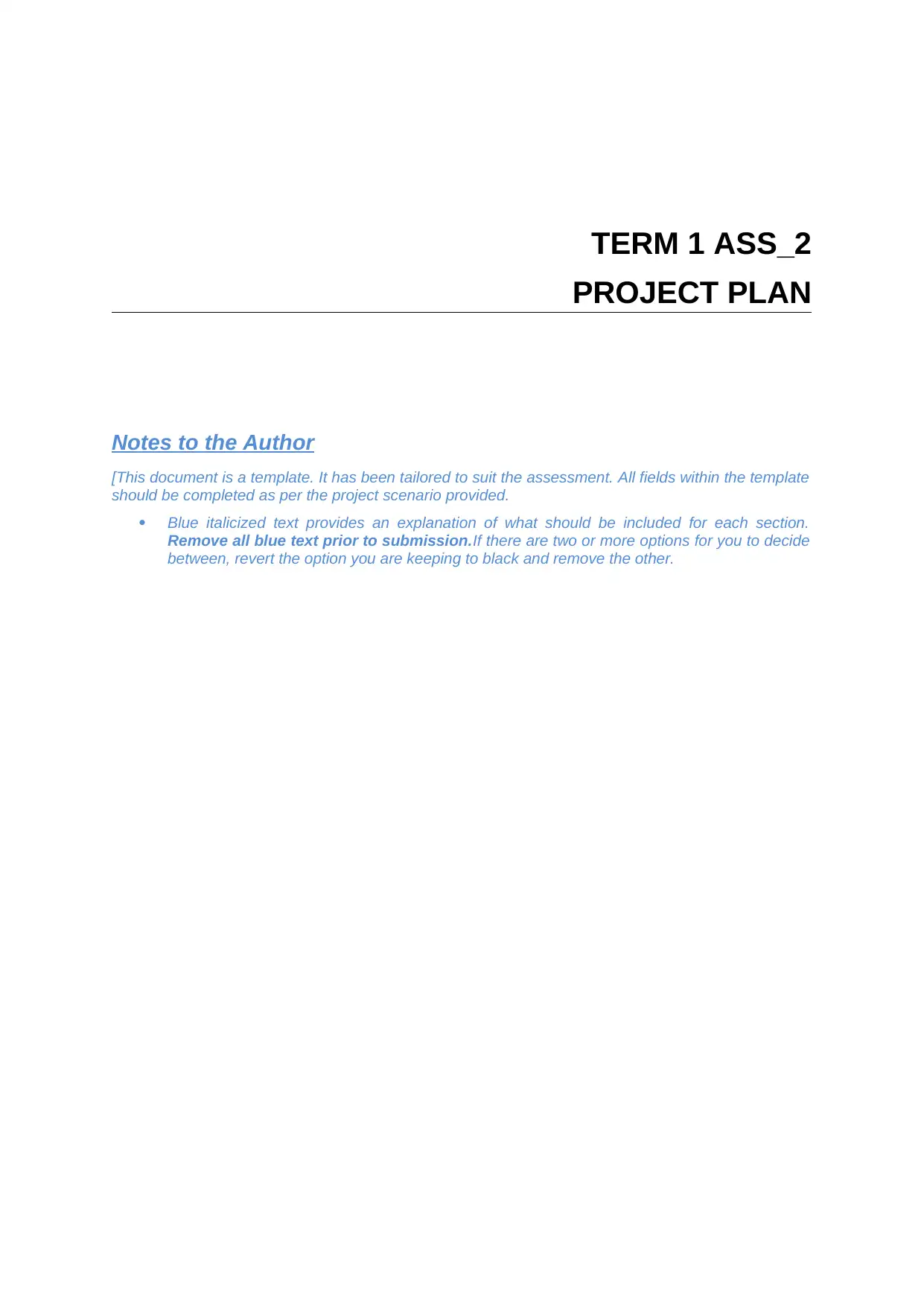
TERM 1 ASS_2
PROJECT PLAN
Notes to the Author
[This document is a template. It has been tailored to suit the assessment. All fields within the template
should be completed as per the project scenario provided.
Blue italicized text provides an explanation of what should be included for each section.
Remove all blue text prior to submission.If there are two or more options for you to decide
between, revert the option you are keeping to black and remove the other.
PROJECT PLAN
Notes to the Author
[This document is a template. It has been tailored to suit the assessment. All fields within the template
should be completed as per the project scenario provided.
Blue italicized text provides an explanation of what should be included for each section.
Remove all blue text prior to submission.If there are two or more options for you to decide
between, revert the option you are keeping to black and remove the other.
Secure Best Marks with AI Grader
Need help grading? Try our AI Grader for instant feedback on your assignments.
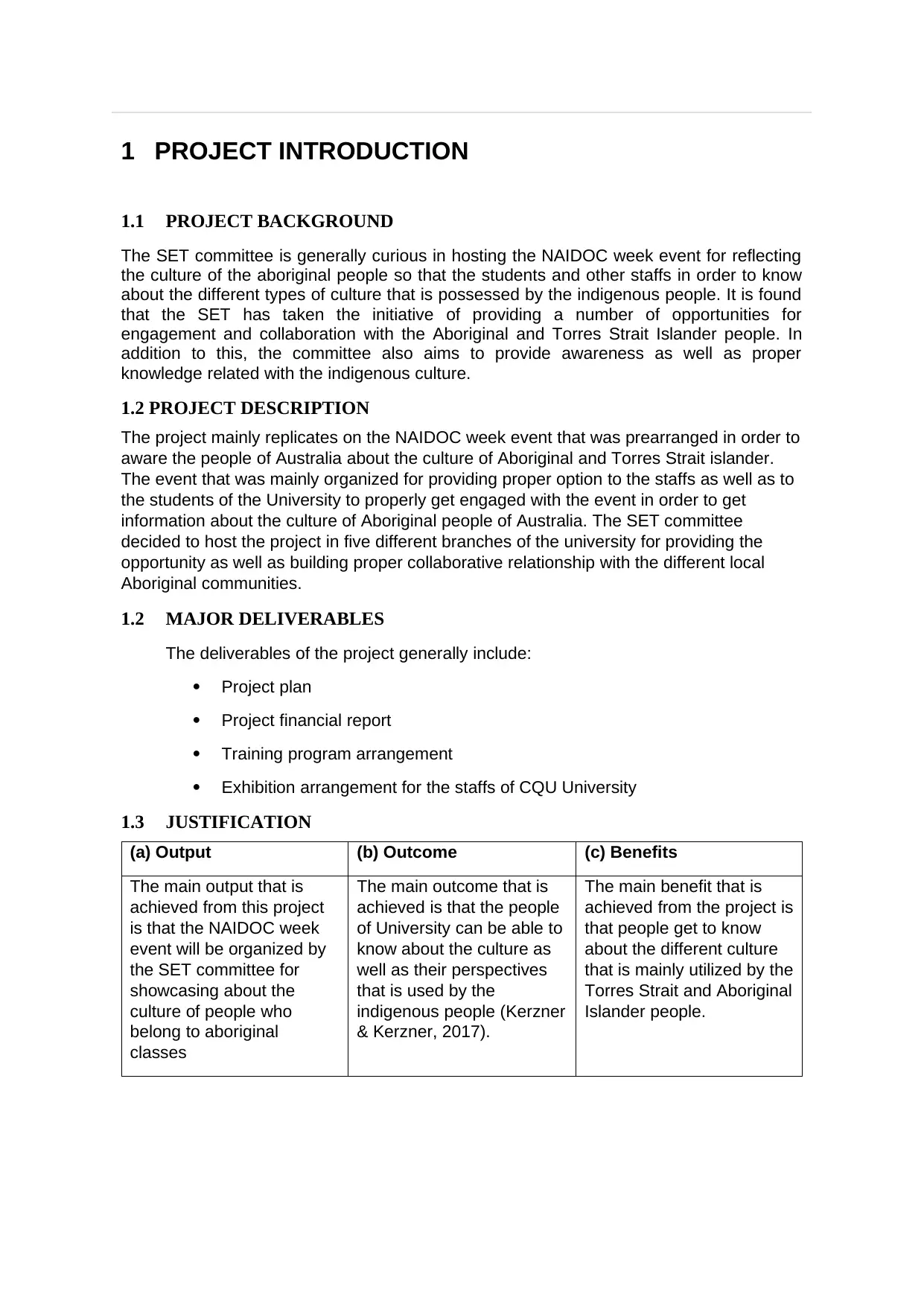
1 PROJECT INTRODUCTION
1.1 PROJECT BACKGROUND
The SET committee is generally curious in hosting the NAIDOC week event for reflecting
the culture of the aboriginal people so that the students and other staffs in order to know
about the different types of culture that is possessed by the indigenous people. It is found
that the SET has taken the initiative of providing a number of opportunities for
engagement and collaboration with the Aboriginal and Torres Strait Islander people. In
addition to this, the committee also aims to provide awareness as well as proper
knowledge related with the indigenous culture.
1.2 PROJECT DESCRIPTION
The project mainly replicates on the NAIDOC week event that was prearranged in order to
aware the people of Australia about the culture of Aboriginal and Torres Strait islander.
The event that was mainly organized for providing proper option to the staffs as well as to
the students of the University to properly get engaged with the event in order to get
information about the culture of Aboriginal people of Australia. The SET committee
decided to host the project in five different branches of the university for providing the
opportunity as well as building proper collaborative relationship with the different local
Aboriginal communities.
1.2 MAJOR DELIVERABLES
The deliverables of the project generally include:
Project plan
Project financial report
Training program arrangement
Exhibition arrangement for the staffs of CQU University
1.3 JUSTIFICATION
(a) Output (b) Outcome (c) Benefits
The main output that is
achieved from this project
is that the NAIDOC week
event will be organized by
the SET committee for
showcasing about the
culture of people who
belong to aboriginal
classes
The main outcome that is
achieved is that the people
of University can be able to
know about the culture as
well as their perspectives
that is used by the
indigenous people (Kerzner
& Kerzner, 2017).
The main benefit that is
achieved from the project is
that people get to know
about the different culture
that is mainly utilized by the
Torres Strait and Aboriginal
Islander people.
1.1 PROJECT BACKGROUND
The SET committee is generally curious in hosting the NAIDOC week event for reflecting
the culture of the aboriginal people so that the students and other staffs in order to know
about the different types of culture that is possessed by the indigenous people. It is found
that the SET has taken the initiative of providing a number of opportunities for
engagement and collaboration with the Aboriginal and Torres Strait Islander people. In
addition to this, the committee also aims to provide awareness as well as proper
knowledge related with the indigenous culture.
1.2 PROJECT DESCRIPTION
The project mainly replicates on the NAIDOC week event that was prearranged in order to
aware the people of Australia about the culture of Aboriginal and Torres Strait islander.
The event that was mainly organized for providing proper option to the staffs as well as to
the students of the University to properly get engaged with the event in order to get
information about the culture of Aboriginal people of Australia. The SET committee
decided to host the project in five different branches of the university for providing the
opportunity as well as building proper collaborative relationship with the different local
Aboriginal communities.
1.2 MAJOR DELIVERABLES
The deliverables of the project generally include:
Project plan
Project financial report
Training program arrangement
Exhibition arrangement for the staffs of CQU University
1.3 JUSTIFICATION
(a) Output (b) Outcome (c) Benefits
The main output that is
achieved from this project
is that the NAIDOC week
event will be organized by
the SET committee for
showcasing about the
culture of people who
belong to aboriginal
classes
The main outcome that is
achieved is that the people
of University can be able to
know about the culture as
well as their perspectives
that is used by the
indigenous people (Kerzner
& Kerzner, 2017).
The main benefit that is
achieved from the project is
that people get to know
about the different culture
that is mainly utilized by the
Torres Strait and Aboriginal
Islander people.
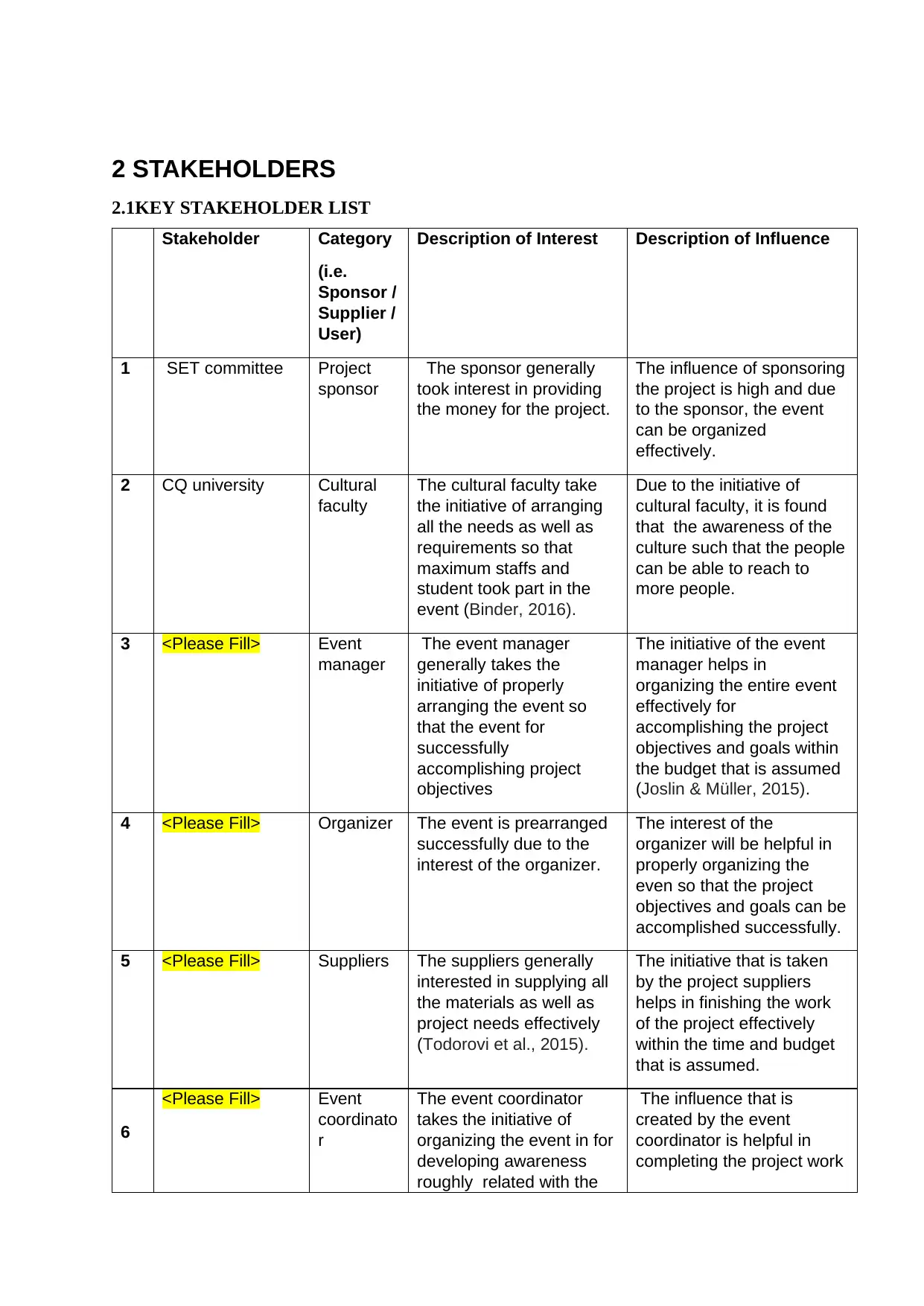
2 STAKEHOLDERS
2.1KEY STAKEHOLDER LIST
Stakeholder Category
(i.e.
Sponsor /
Supplier /
User)
Description of Interest Description of Influence
1 SET committee Project
sponsor
The sponsor generally
took interest in providing
the money for the project.
The influence of sponsoring
the project is high and due
to the sponsor, the event
can be organized
effectively.
2 CQ university Cultural
faculty
The cultural faculty take
the initiative of arranging
all the needs as well as
requirements so that
maximum staffs and
student took part in the
event (Binder, 2016).
Due to the initiative of
cultural faculty, it is found
that the awareness of the
culture such that the people
can be able to reach to
more people.
3 <Please Fill> Event
manager
The event manager
generally takes the
initiative of properly
arranging the event so
that the event for
successfully
accomplishing project
objectives
The initiative of the event
manager helps in
organizing the entire event
effectively for
accomplishing the project
objectives and goals within
the budget that is assumed
(Joslin & Müller, 2015).
4 <Please Fill> Organizer The event is prearranged
successfully due to the
interest of the organizer.
The interest of the
organizer will be helpful in
properly organizing the
even so that the project
objectives and goals can be
accomplished successfully.
5 <Please Fill> Suppliers The suppliers generally
interested in supplying all
the materials as well as
project needs effectively
(Todorovi et al., 2015).
The initiative that is taken
by the project suppliers
helps in finishing the work
of the project effectively
within the time and budget
that is assumed.
6
<Please Fill> Event
coordinato
r
The event coordinator
takes the initiative of
organizing the event in for
developing awareness
roughly related with the
The influence that is
created by the event
coordinator is helpful in
completing the project work
2.1KEY STAKEHOLDER LIST
Stakeholder Category
(i.e.
Sponsor /
Supplier /
User)
Description of Interest Description of Influence
1 SET committee Project
sponsor
The sponsor generally
took interest in providing
the money for the project.
The influence of sponsoring
the project is high and due
to the sponsor, the event
can be organized
effectively.
2 CQ university Cultural
faculty
The cultural faculty take
the initiative of arranging
all the needs as well as
requirements so that
maximum staffs and
student took part in the
event (Binder, 2016).
Due to the initiative of
cultural faculty, it is found
that the awareness of the
culture such that the people
can be able to reach to
more people.
3 <Please Fill> Event
manager
The event manager
generally takes the
initiative of properly
arranging the event so
that the event for
successfully
accomplishing project
objectives
The initiative of the event
manager helps in
organizing the entire event
effectively for
accomplishing the project
objectives and goals within
the budget that is assumed
(Joslin & Müller, 2015).
4 <Please Fill> Organizer The event is prearranged
successfully due to the
interest of the organizer.
The interest of the
organizer will be helpful in
properly organizing the
even so that the project
objectives and goals can be
accomplished successfully.
5 <Please Fill> Suppliers The suppliers generally
interested in supplying all
the materials as well as
project needs effectively
(Todorovi et al., 2015).
The initiative that is taken
by the project suppliers
helps in finishing the work
of the project effectively
within the time and budget
that is assumed.
6
<Please Fill> Event
coordinato
r
The event coordinator
takes the initiative of
organizing the event in for
developing awareness
roughly related with the
The influence that is
created by the event
coordinator is helpful in
completing the project work
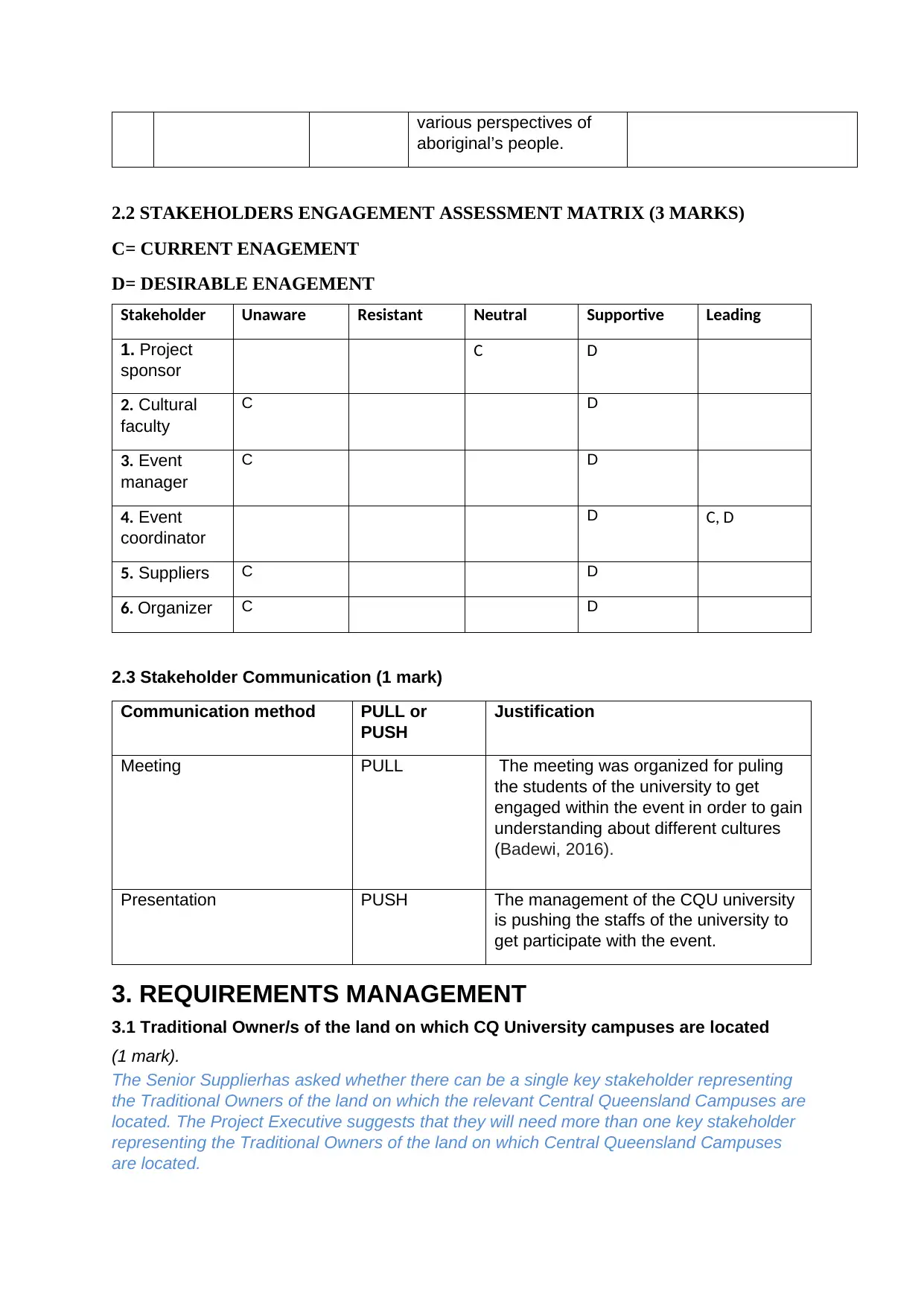
various perspectives of
aboriginal’s people.
2.2 STAKEHOLDERS ENGAGEMENT ASSESSMENT MATRIX (3 MARKS)
C= CURRENT ENAGEMENT
D= DESIRABLE ENAGEMENT
Stakeholder Unaware Resistant Neutral Supportive Leading
1. Project
sponsor
C D
2. Cultural
faculty
C D
3. Event
manager
C D
4. Event
coordinator
D C, D
5. Suppliers C D
6. Organizer C D
2.3 Stakeholder Communication (1 mark)
Communication method PULL or
PUSH
Justification
Meeting PULL The meeting was organized for puling
the students of the university to get
engaged within the event in order to gain
understanding about different cultures
(Badewi, 2016).
Presentation PUSH The management of the CQU university
is pushing the staffs of the university to
get participate with the event.
3. REQUIREMENTS MANAGEMENT
3.1 Traditional Owner/s of the land on which CQ University campuses are located
(1 mark).
The Senior Supplierhas asked whether there can be a single key stakeholder representing
the Traditional Owners of the land on which the relevant Central Queensland Campuses are
located. The Project Executive suggests that they will need more than one key stakeholder
representing the Traditional Owners of the land on which Central Queensland Campuses
are located.
aboriginal’s people.
2.2 STAKEHOLDERS ENGAGEMENT ASSESSMENT MATRIX (3 MARKS)
C= CURRENT ENAGEMENT
D= DESIRABLE ENAGEMENT
Stakeholder Unaware Resistant Neutral Supportive Leading
1. Project
sponsor
C D
2. Cultural
faculty
C D
3. Event
manager
C D
4. Event
coordinator
D C, D
5. Suppliers C D
6. Organizer C D
2.3 Stakeholder Communication (1 mark)
Communication method PULL or
PUSH
Justification
Meeting PULL The meeting was organized for puling
the students of the university to get
engaged within the event in order to gain
understanding about different cultures
(Badewi, 2016).
Presentation PUSH The management of the CQU university
is pushing the staffs of the university to
get participate with the event.
3. REQUIREMENTS MANAGEMENT
3.1 Traditional Owner/s of the land on which CQ University campuses are located
(1 mark).
The Senior Supplierhas asked whether there can be a single key stakeholder representing
the Traditional Owners of the land on which the relevant Central Queensland Campuses are
located. The Project Executive suggests that they will need more than one key stakeholder
representing the Traditional Owners of the land on which Central Queensland Campuses
are located.
Secure Best Marks with AI Grader
Need help grading? Try our AI Grader for instant feedback on your assignments.
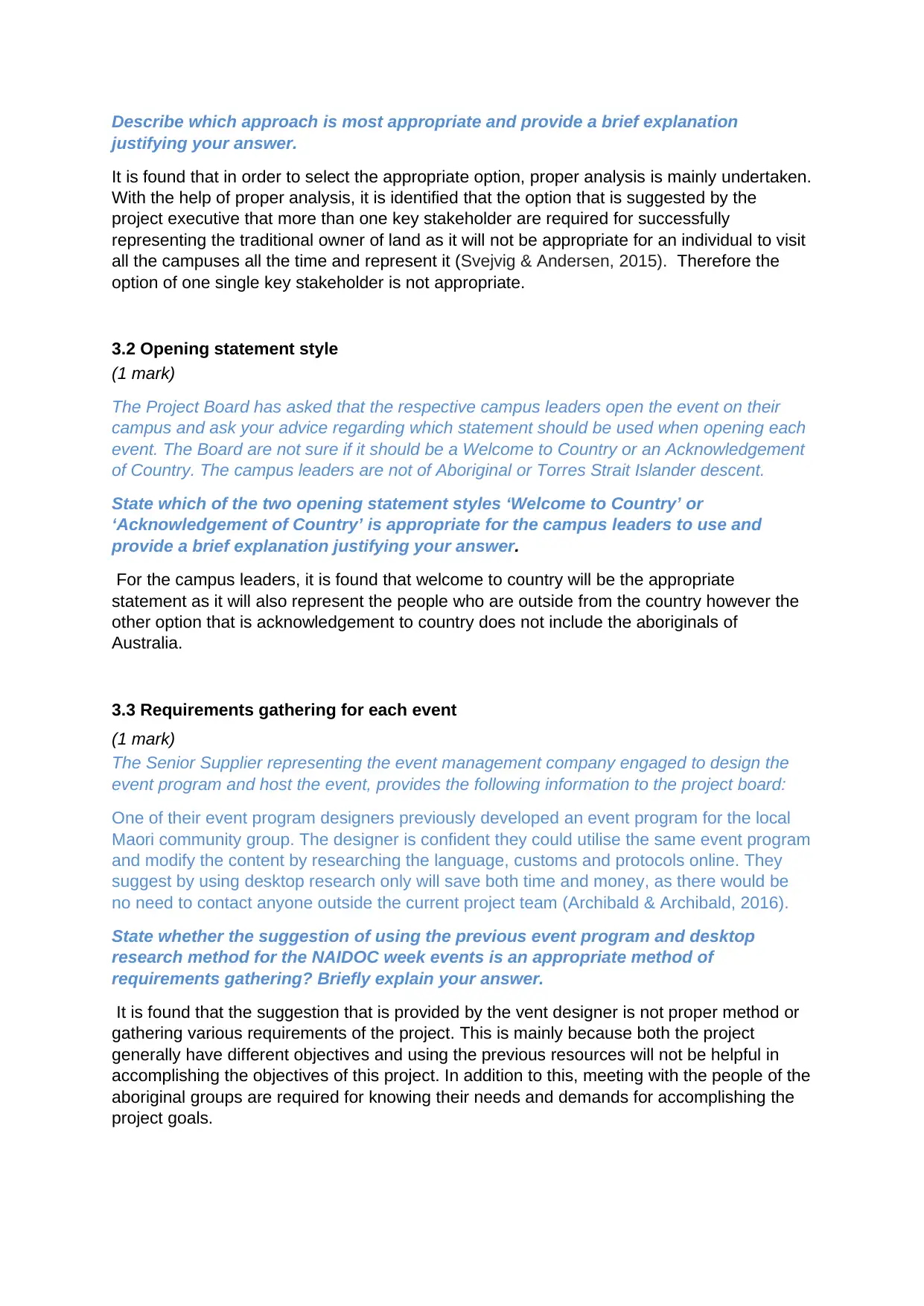
Describe which approach is most appropriate and provide a brief explanation
justifying your answer.
It is found that in order to select the appropriate option, proper analysis is mainly undertaken.
With the help of proper analysis, it is identified that the option that is suggested by the
project executive that more than one key stakeholder are required for successfully
representing the traditional owner of land as it will not be appropriate for an individual to visit
all the campuses all the time and represent it (Svejvig & Andersen, 2015). Therefore the
option of one single key stakeholder is not appropriate.
3.2 Opening statement style
(1 mark)
The Project Board has asked that the respective campus leaders open the event on their
campus and ask your advice regarding which statement should be used when opening each
event. The Board are not sure if it should be a Welcome to Country or an Acknowledgement
of Country. The campus leaders are not of Aboriginal or Torres Strait Islander descent.
State which of the two opening statement styles ‘Welcome to Country’ or
‘Acknowledgement of Country’ is appropriate for the campus leaders to use and
provide a brief explanation justifying your answer.
For the campus leaders, it is found that welcome to country will be the appropriate
statement as it will also represent the people who are outside from the country however the
other option that is acknowledgement to country does not include the aboriginals of
Australia.
3.3 Requirements gathering for each event
(1 mark)
The Senior Supplier representing the event management company engaged to design the
event program and host the event, provides the following information to the project board:
One of their event program designers previously developed an event program for the local
Maori community group. The designer is confident they could utilise the same event program
and modify the content by researching the language, customs and protocols online. They
suggest by using desktop research only will save both time and money, as there would be
no need to contact anyone outside the current project team (Archibald & Archibald, 2016).
State whether the suggestion of using the previous event program and desktop
research method for the NAIDOC week events is an appropriate method of
requirements gathering? Briefly explain your answer.
It is found that the suggestion that is provided by the vent designer is not proper method or
gathering various requirements of the project. This is mainly because both the project
generally have different objectives and using the previous resources will not be helpful in
accomplishing the objectives of this project. In addition to this, meeting with the people of the
aboriginal groups are required for knowing their needs and demands for accomplishing the
project goals.
justifying your answer.
It is found that in order to select the appropriate option, proper analysis is mainly undertaken.
With the help of proper analysis, it is identified that the option that is suggested by the
project executive that more than one key stakeholder are required for successfully
representing the traditional owner of land as it will not be appropriate for an individual to visit
all the campuses all the time and represent it (Svejvig & Andersen, 2015). Therefore the
option of one single key stakeholder is not appropriate.
3.2 Opening statement style
(1 mark)
The Project Board has asked that the respective campus leaders open the event on their
campus and ask your advice regarding which statement should be used when opening each
event. The Board are not sure if it should be a Welcome to Country or an Acknowledgement
of Country. The campus leaders are not of Aboriginal or Torres Strait Islander descent.
State which of the two opening statement styles ‘Welcome to Country’ or
‘Acknowledgement of Country’ is appropriate for the campus leaders to use and
provide a brief explanation justifying your answer.
For the campus leaders, it is found that welcome to country will be the appropriate
statement as it will also represent the people who are outside from the country however the
other option that is acknowledgement to country does not include the aboriginals of
Australia.
3.3 Requirements gathering for each event
(1 mark)
The Senior Supplier representing the event management company engaged to design the
event program and host the event, provides the following information to the project board:
One of their event program designers previously developed an event program for the local
Maori community group. The designer is confident they could utilise the same event program
and modify the content by researching the language, customs and protocols online. They
suggest by using desktop research only will save both time and money, as there would be
no need to contact anyone outside the current project team (Archibald & Archibald, 2016).
State whether the suggestion of using the previous event program and desktop
research method for the NAIDOC week events is an appropriate method of
requirements gathering? Briefly explain your answer.
It is found that the suggestion that is provided by the vent designer is not proper method or
gathering various requirements of the project. This is mainly because both the project
generally have different objectives and using the previous resources will not be helpful in
accomplishing the objectives of this project. In addition to this, meeting with the people of the
aboriginal groups are required for knowing their needs and demands for accomplishing the
project goals.
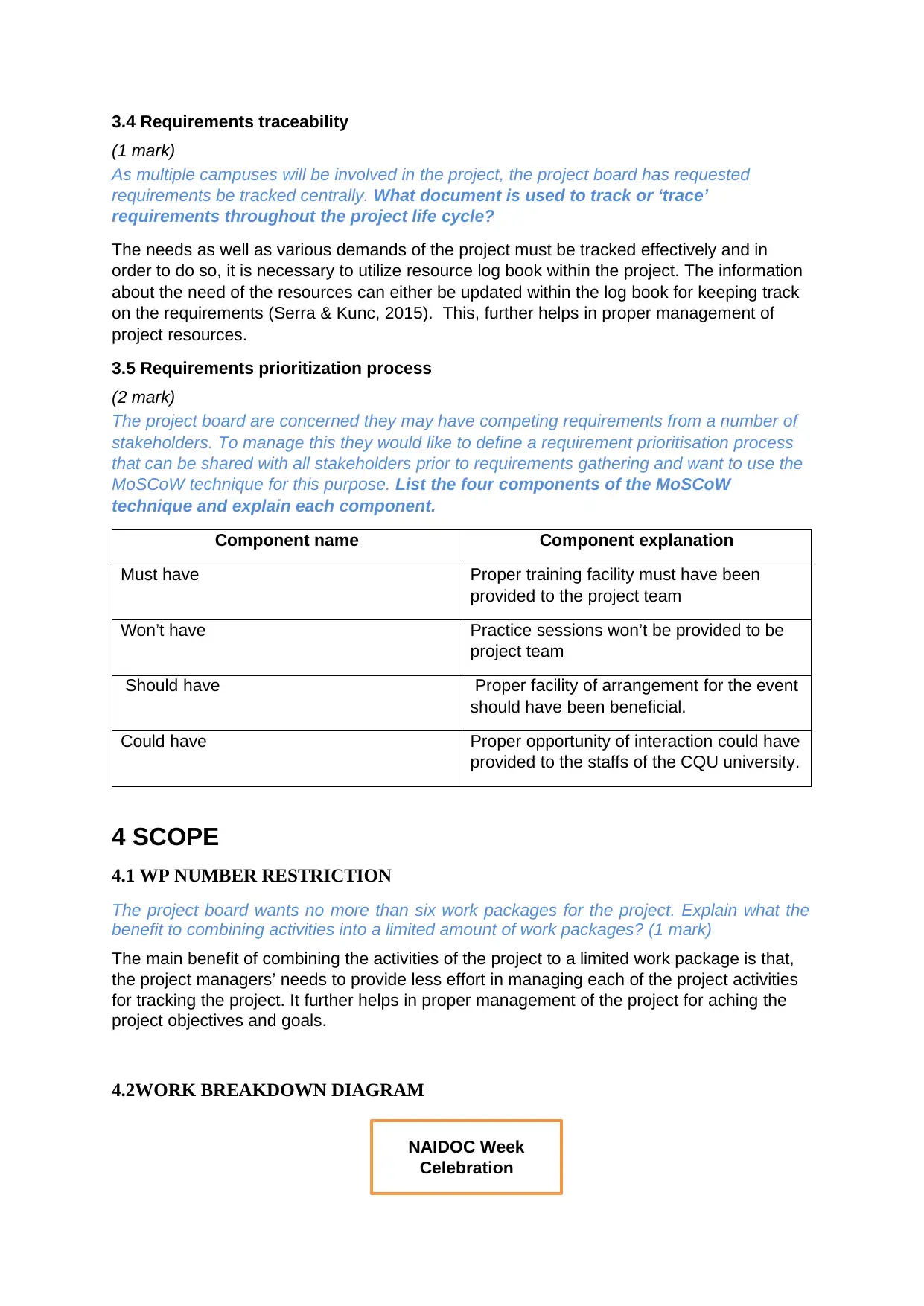
3.4 Requirements traceability
(1 mark)
As multiple campuses will be involved in the project, the project board has requested
requirements be tracked centrally. What document is used to track or ‘trace’
requirements throughout the project life cycle?
The needs as well as various demands of the project must be tracked effectively and in
order to do so, it is necessary to utilize resource log book within the project. The information
about the need of the resources can either be updated within the log book for keeping track
on the requirements (Serra & Kunc, 2015). This, further helps in proper management of
project resources.
3.5 Requirements prioritization process
(2 mark)
The project board are concerned they may have competing requirements from a number of
stakeholders. To manage this they would like to define a requirement prioritisation process
that can be shared with all stakeholders prior to requirements gathering and want to use the
MoSCoW technique for this purpose. List the four components of the MoSCoW
technique and explain each component.
Component name Component explanation
Must have Proper training facility must have been
provided to the project team
Won’t have Practice sessions won’t be provided to be
project team
Should have Proper facility of arrangement for the event
should have been beneficial.
Could have Proper opportunity of interaction could have
provided to the staffs of the CQU university.
4 SCOPE
4.1 WP NUMBER RESTRICTION
The project board wants no more than six work packages for the project. Explain what the
benefit to combining activities into a limited amount of work packages? (1 mark)
The main benefit of combining the activities of the project to a limited work package is that,
the project managers’ needs to provide less effort in managing each of the project activities
for tracking the project. It further helps in proper management of the project for aching the
project objectives and goals.
4.2WORK BREAKDOWN DIAGRAM
NAIDOC Week
Celebration
(1 mark)
As multiple campuses will be involved in the project, the project board has requested
requirements be tracked centrally. What document is used to track or ‘trace’
requirements throughout the project life cycle?
The needs as well as various demands of the project must be tracked effectively and in
order to do so, it is necessary to utilize resource log book within the project. The information
about the need of the resources can either be updated within the log book for keeping track
on the requirements (Serra & Kunc, 2015). This, further helps in proper management of
project resources.
3.5 Requirements prioritization process
(2 mark)
The project board are concerned they may have competing requirements from a number of
stakeholders. To manage this they would like to define a requirement prioritisation process
that can be shared with all stakeholders prior to requirements gathering and want to use the
MoSCoW technique for this purpose. List the four components of the MoSCoW
technique and explain each component.
Component name Component explanation
Must have Proper training facility must have been
provided to the project team
Won’t have Practice sessions won’t be provided to be
project team
Should have Proper facility of arrangement for the event
should have been beneficial.
Could have Proper opportunity of interaction could have
provided to the staffs of the CQU university.
4 SCOPE
4.1 WP NUMBER RESTRICTION
The project board wants no more than six work packages for the project. Explain what the
benefit to combining activities into a limited amount of work packages? (1 mark)
The main benefit of combining the activities of the project to a limited work package is that,
the project managers’ needs to provide less effort in managing each of the project activities
for tracking the project. It further helps in proper management of the project for aching the
project objectives and goals.
4.2WORK BREAKDOWN DIAGRAM
NAIDOC Week
Celebration
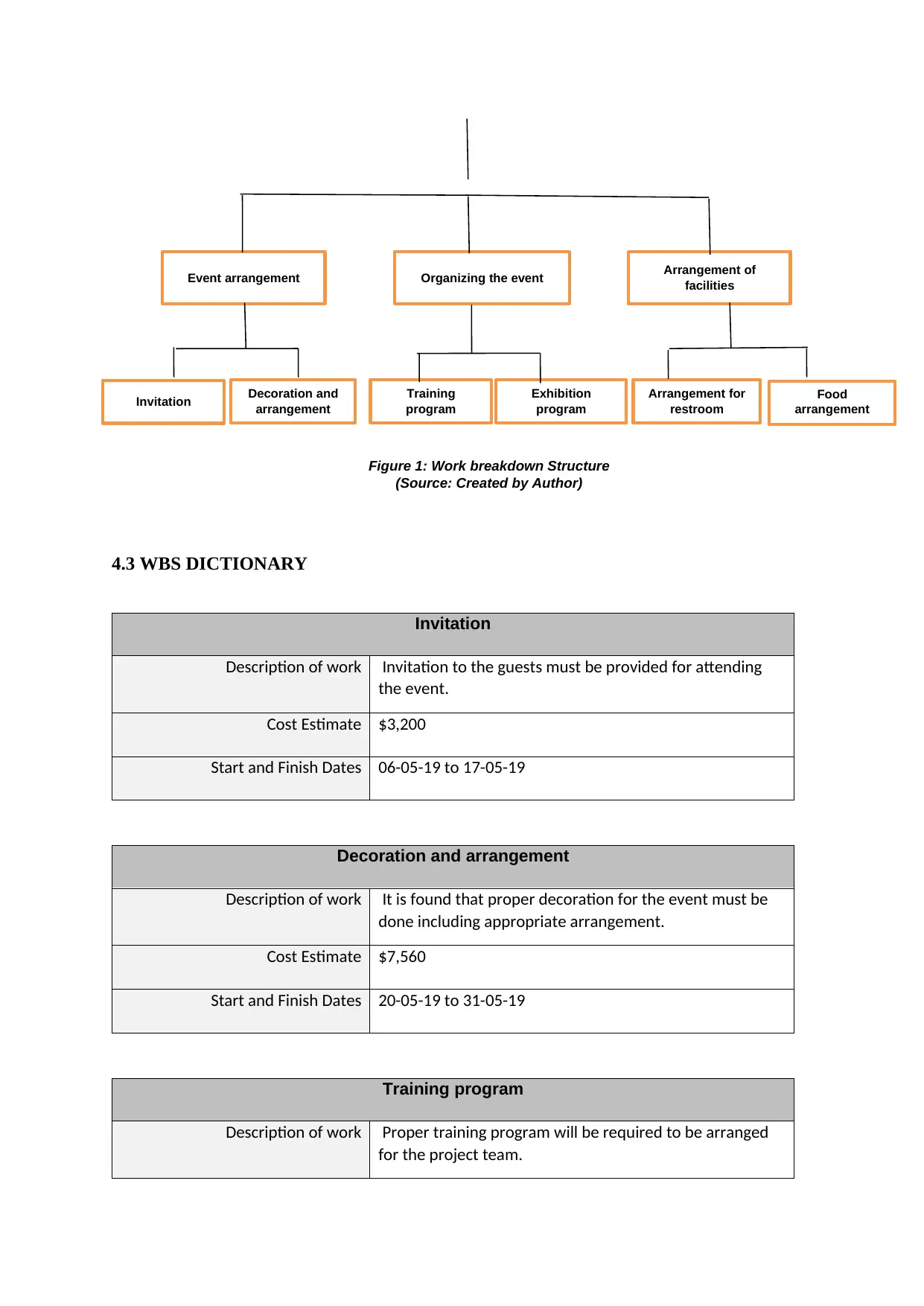
Figure 1: Work breakdown Structure
(Source: Created by Author)
4.3 WBS DICTIONARY
Invitation
Description of work Invitation to the guests must be provided for attending
the event.
Cost Estimate $3,200
Start and Finish Dates 06-05-19 to 17-05-19
Decoration and arrangement
Description of work It is found that proper decoration for the event must be
done including appropriate arrangement.
Cost Estimate $7,560
Start and Finish Dates 20-05-19 to 31-05-19
Training program
Description of work Proper training program will be required to be arranged
for the project team.
Arrangement of
facilities
Organizing the eventEvent arrangement
Food
arrangement
Arrangement for
restroom
Exhibition
program
Training
program
Decoration and
arrangement
Invitation
(Source: Created by Author)
4.3 WBS DICTIONARY
Invitation
Description of work Invitation to the guests must be provided for attending
the event.
Cost Estimate $3,200
Start and Finish Dates 06-05-19 to 17-05-19
Decoration and arrangement
Description of work It is found that proper decoration for the event must be
done including appropriate arrangement.
Cost Estimate $7,560
Start and Finish Dates 20-05-19 to 31-05-19
Training program
Description of work Proper training program will be required to be arranged
for the project team.
Arrangement of
facilities
Organizing the eventEvent arrangement
Food
arrangement
Arrangement for
restroom
Exhibition
program
Training
program
Decoration and
arrangement
Invitation
Paraphrase This Document
Need a fresh take? Get an instant paraphrase of this document with our AI Paraphraser
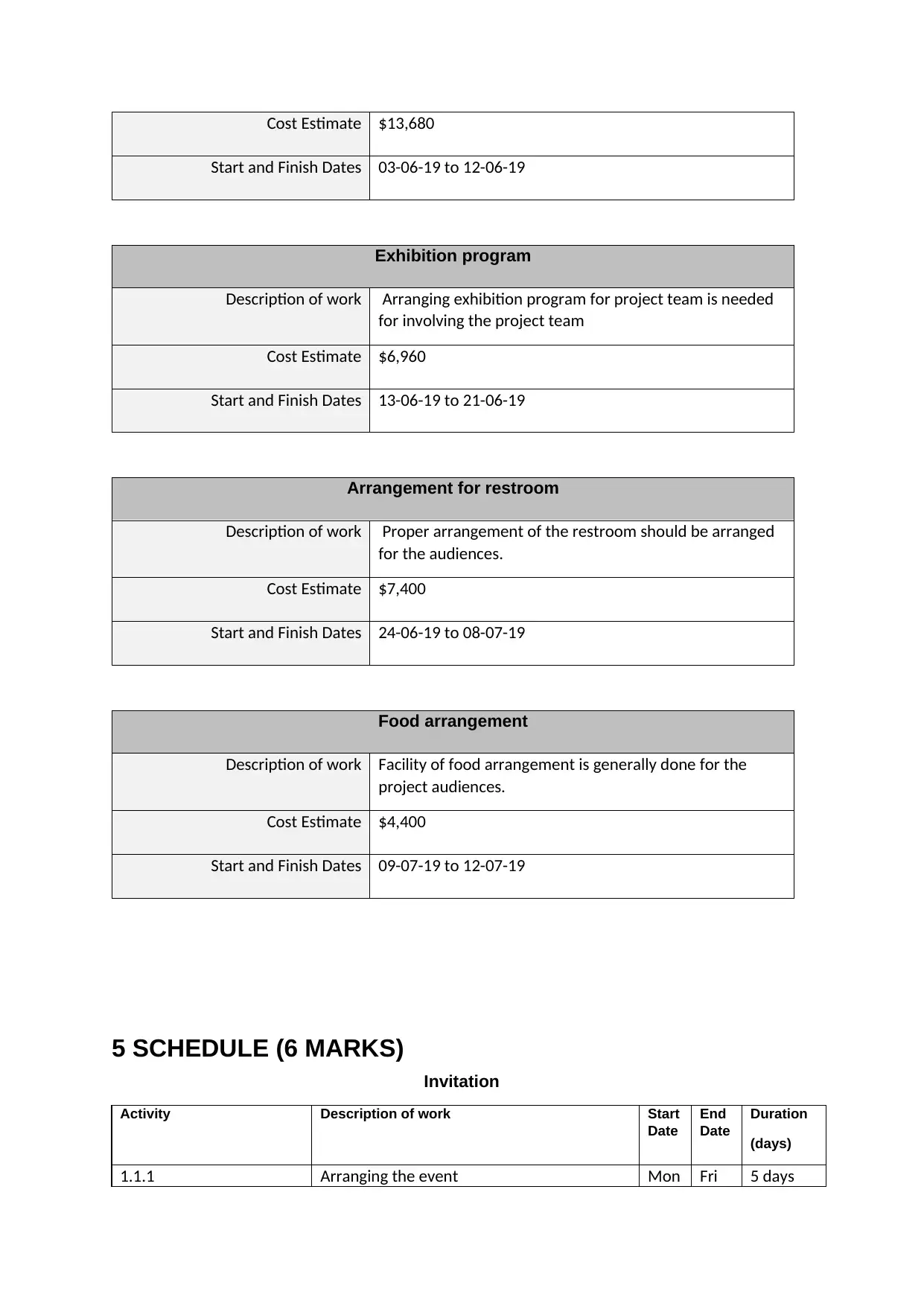
Cost Estimate $13,680
Start and Finish Dates 03-06-19 to 12-06-19
Exhibition program
Description of work Arranging exhibition program for project team is needed
for involving the project team
Cost Estimate $6,960
Start and Finish Dates 13-06-19 to 21-06-19
Arrangement for restroom
Description of work Proper arrangement of the restroom should be arranged
for the audiences.
Cost Estimate $7,400
Start and Finish Dates 24-06-19 to 08-07-19
Food arrangement
Description of work Facility of food arrangement is generally done for the
project audiences.
Cost Estimate $4,400
Start and Finish Dates 09-07-19 to 12-07-19
5 SCHEDULE (6 MARKS)
Invitation
Activity Description of work Start
Date
End
Date
Duration
(days)
1.1.1 Arranging the event Mon Fri 5 days
Start and Finish Dates 03-06-19 to 12-06-19
Exhibition program
Description of work Arranging exhibition program for project team is needed
for involving the project team
Cost Estimate $6,960
Start and Finish Dates 13-06-19 to 21-06-19
Arrangement for restroom
Description of work Proper arrangement of the restroom should be arranged
for the audiences.
Cost Estimate $7,400
Start and Finish Dates 24-06-19 to 08-07-19
Food arrangement
Description of work Facility of food arrangement is generally done for the
project audiences.
Cost Estimate $4,400
Start and Finish Dates 09-07-19 to 12-07-19
5 SCHEDULE (6 MARKS)
Invitation
Activity Description of work Start
Date
End
Date
Duration
(days)
1.1.1 Arranging the event Mon Fri 5 days
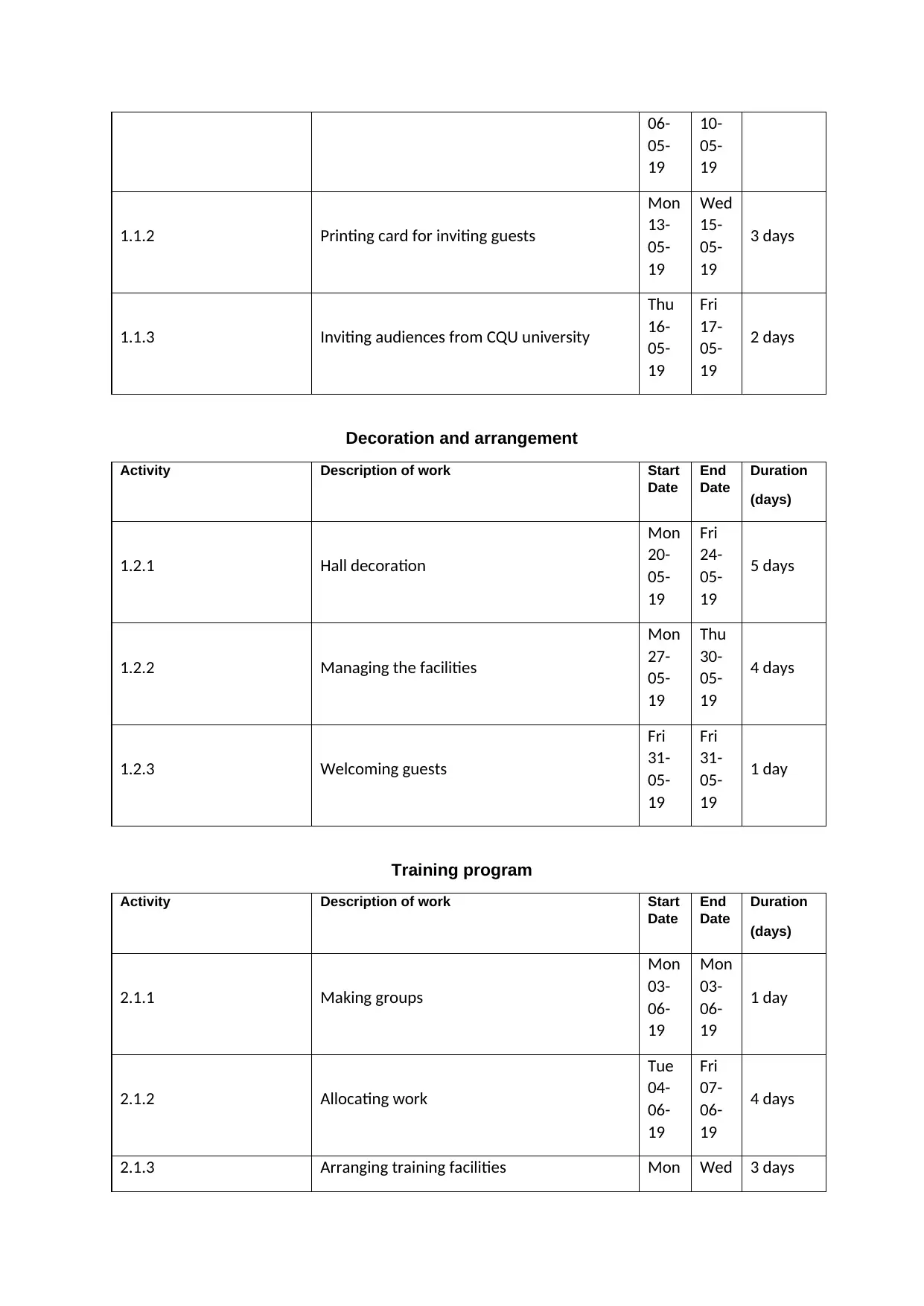
06-
05-
19
10-
05-
19
1.1.2 Printing card for inviting guests
Mon
13-
05-
19
Wed
15-
05-
19
3 days
1.1.3 Inviting audiences from CQU university
Thu
16-
05-
19
Fri
17-
05-
19
2 days
Decoration and arrangement
Activity Description of work Start
Date
End
Date
Duration
(days)
1.2.1 Hall decoration
Mon
20-
05-
19
Fri
24-
05-
19
5 days
1.2.2 Managing the facilities
Mon
27-
05-
19
Thu
30-
05-
19
4 days
1.2.3 Welcoming guests
Fri
31-
05-
19
Fri
31-
05-
19
1 day
Training program
Activity Description of work Start
Date
End
Date
Duration
(days)
2.1.1 Making groups
Mon
03-
06-
19
Mon
03-
06-
19
1 day
2.1.2 Allocating work
Tue
04-
06-
19
Fri
07-
06-
19
4 days
2.1.3 Arranging training facilities Mon Wed 3 days
05-
19
10-
05-
19
1.1.2 Printing card for inviting guests
Mon
13-
05-
19
Wed
15-
05-
19
3 days
1.1.3 Inviting audiences from CQU university
Thu
16-
05-
19
Fri
17-
05-
19
2 days
Decoration and arrangement
Activity Description of work Start
Date
End
Date
Duration
(days)
1.2.1 Hall decoration
Mon
20-
05-
19
Fri
24-
05-
19
5 days
1.2.2 Managing the facilities
Mon
27-
05-
19
Thu
30-
05-
19
4 days
1.2.3 Welcoming guests
Fri
31-
05-
19
Fri
31-
05-
19
1 day
Training program
Activity Description of work Start
Date
End
Date
Duration
(days)
2.1.1 Making groups
Mon
03-
06-
19
Mon
03-
06-
19
1 day
2.1.2 Allocating work
Tue
04-
06-
19
Fri
07-
06-
19
4 days
2.1.3 Arranging training facilities Mon Wed 3 days
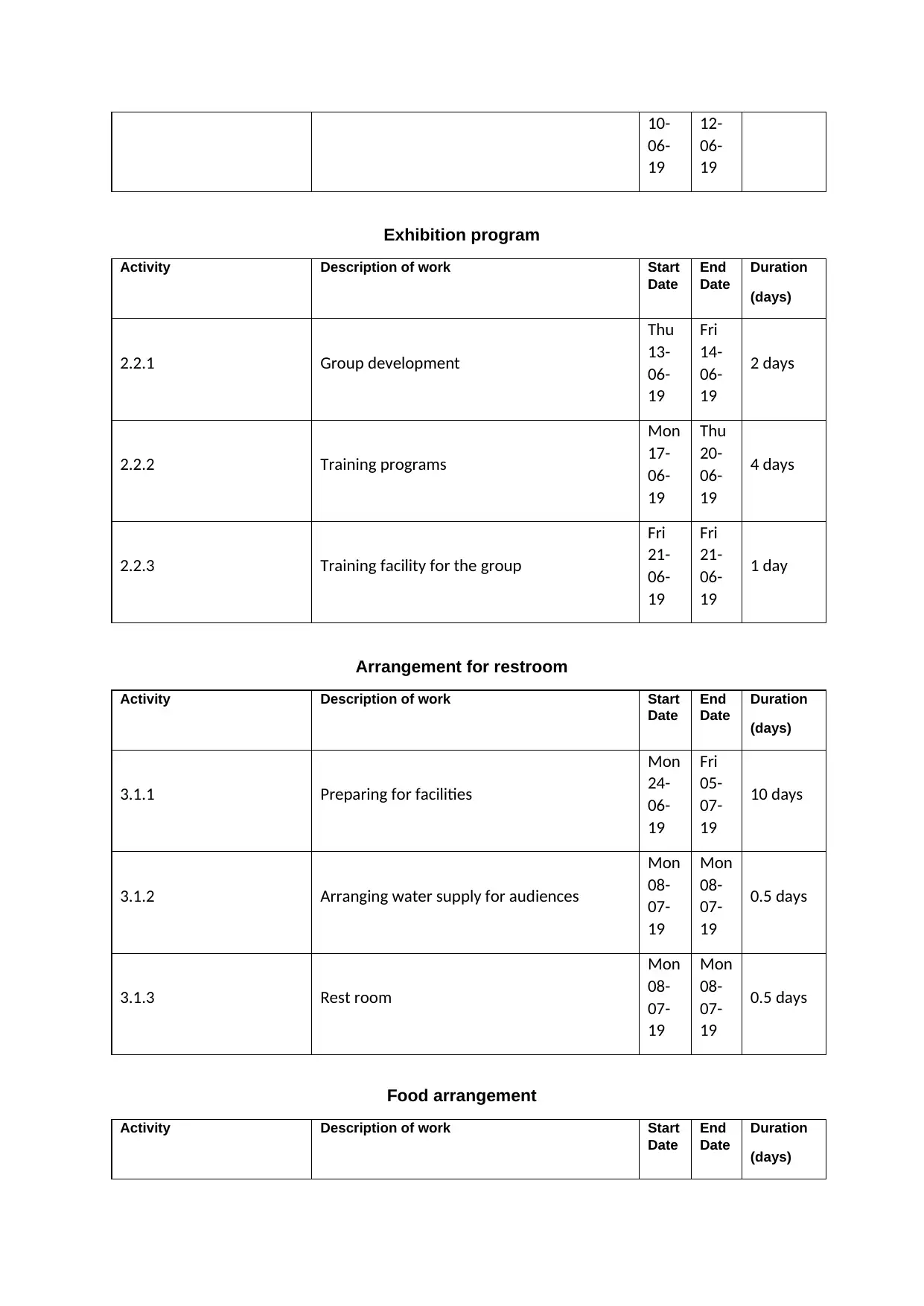
10-
06-
19
12-
06-
19
Exhibition program
Activity Description of work Start
Date
End
Date
Duration
(days)
2.2.1 Group development
Thu
13-
06-
19
Fri
14-
06-
19
2 days
2.2.2 Training programs
Mon
17-
06-
19
Thu
20-
06-
19
4 days
2.2.3 Training facility for the group
Fri
21-
06-
19
Fri
21-
06-
19
1 day
Arrangement for restroom
Activity Description of work Start
Date
End
Date
Duration
(days)
3.1.1 Preparing for facilities
Mon
24-
06-
19
Fri
05-
07-
19
10 days
3.1.2 Arranging water supply for audiences
Mon
08-
07-
19
Mon
08-
07-
19
0.5 days
3.1.3 Rest room
Mon
08-
07-
19
Mon
08-
07-
19
0.5 days
Food arrangement
Activity Description of work Start
Date
End
Date
Duration
(days)
06-
19
12-
06-
19
Exhibition program
Activity Description of work Start
Date
End
Date
Duration
(days)
2.2.1 Group development
Thu
13-
06-
19
Fri
14-
06-
19
2 days
2.2.2 Training programs
Mon
17-
06-
19
Thu
20-
06-
19
4 days
2.2.3 Training facility for the group
Fri
21-
06-
19
Fri
21-
06-
19
1 day
Arrangement for restroom
Activity Description of work Start
Date
End
Date
Duration
(days)
3.1.1 Preparing for facilities
Mon
24-
06-
19
Fri
05-
07-
19
10 days
3.1.2 Arranging water supply for audiences
Mon
08-
07-
19
Mon
08-
07-
19
0.5 days
3.1.3 Rest room
Mon
08-
07-
19
Mon
08-
07-
19
0.5 days
Food arrangement
Activity Description of work Start
Date
End
Date
Duration
(days)
Secure Best Marks with AI Grader
Need help grading? Try our AI Grader for instant feedback on your assignments.
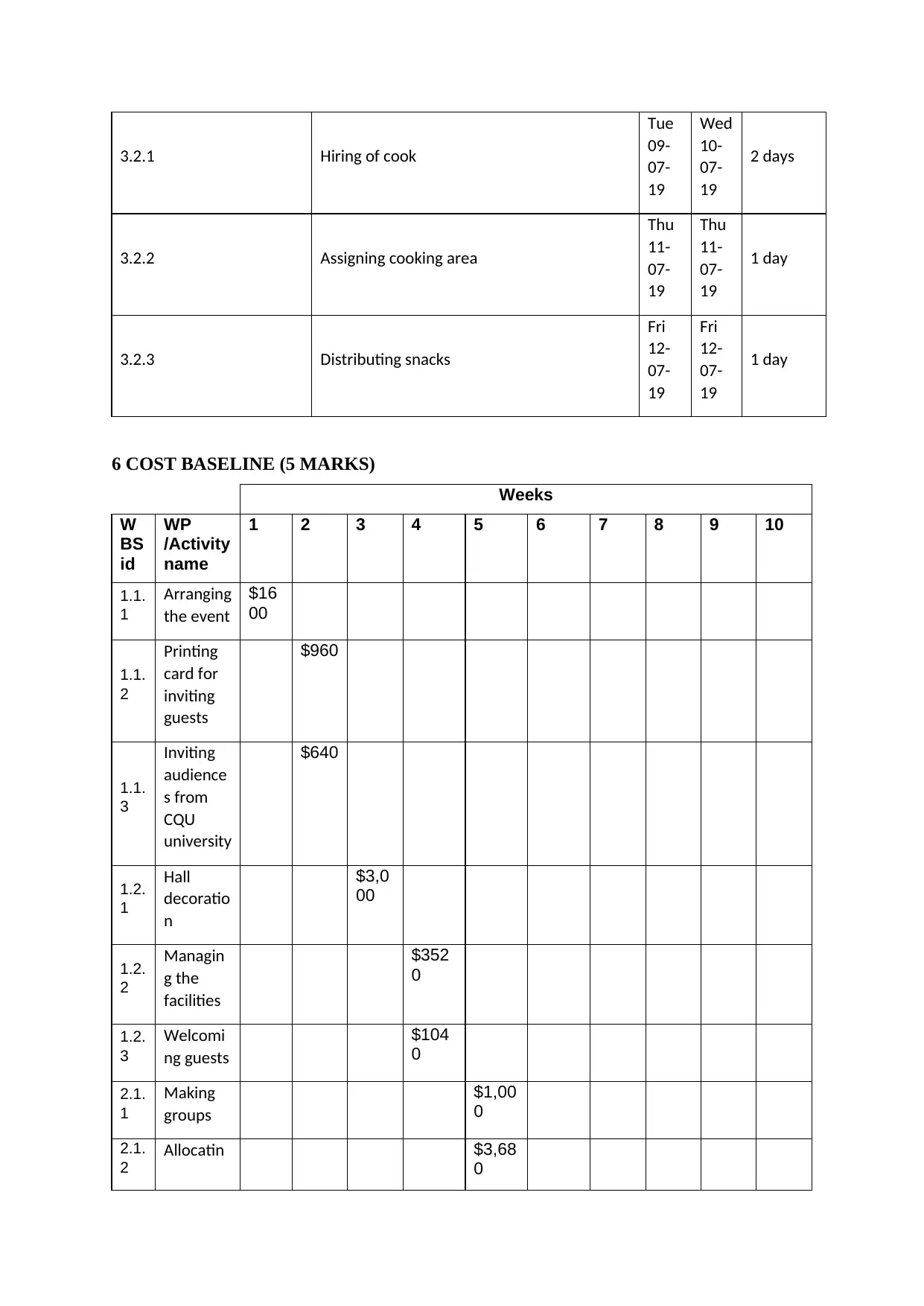
3.2.1 Hiring of cook
Tue
09-
07-
19
Wed
10-
07-
19
2 days
3.2.2 Assigning cooking area
Thu
11-
07-
19
Thu
11-
07-
19
1 day
3.2.3 Distributing snacks
Fri
12-
07-
19
Fri
12-
07-
19
1 day
6 COST BASELINE (5 MARKS)
Weeks
W
BS
id
WP
/Activity
name
1 2 3 4 5 6 7 8 9 10
1.1.
1
Arranging
the event
$16
00
1.1.
2
Printing
card for
inviting
guests
$960
1.1.
3
Inviting
audience
s from
CQU
university
$640
1.2.
1
Hall
decoratio
n
$3,0
00
1.2.
2
Managin
g the
facilities
$352
0
1.2.
3
Welcomi
ng guests
$104
0
2.1.
1
Making
groups
$1,00
0
2.1.
2
Allocatin $3,68
0
Tue
09-
07-
19
Wed
10-
07-
19
2 days
3.2.2 Assigning cooking area
Thu
11-
07-
19
Thu
11-
07-
19
1 day
3.2.3 Distributing snacks
Fri
12-
07-
19
Fri
12-
07-
19
1 day
6 COST BASELINE (5 MARKS)
Weeks
W
BS
id
WP
/Activity
name
1 2 3 4 5 6 7 8 9 10
1.1.
1
Arranging
the event
$16
00
1.1.
2
Printing
card for
inviting
guests
$960
1.1.
3
Inviting
audience
s from
CQU
university
$640
1.2.
1
Hall
decoratio
n
$3,0
00
1.2.
2
Managin
g the
facilities
$352
0
1.2.
3
Welcomi
ng guests
$104
0
2.1.
1
Making
groups
$1,00
0
2.1.
2
Allocatin $3,68
0

g work
2.1.
3
Arranging
training
facilities
$204
0
2.2.
1
Group
develop
ment
$208
0
2.2.
2
Training
programs
$400
0
2.2.
3
Training
facility
for the
group
$880
3.1.
1
Preparing
for
facilities
$6,4
00
3.1.
2
Arranging
water
supply
for
audience
s
$500
3.1.
3
Rest
room
$500
3.2.
1
Hiring of
cook
$208
0
3.2.
2
Assigning
cooking
area
$100
0
3.2.
3
Distributi
ng snacks
$1,3
20
Total
weekly
cost
$16
00
$16
00
$3,0
00
$4,5
60
$4,6
80
$4,1
20
$4,8
80
$6,4
00
$1,0
00
$44
00
Cumul
ative
cost
$16
00
$3,2
00
$6,2
00
$10,
760
$15,
440
$19,
560
24,4
40
30,8
40
31,8
40
36,2
40
7 RISKS
Risk Register
2.1.
3
Arranging
training
facilities
$204
0
2.2.
1
Group
develop
ment
$208
0
2.2.
2
Training
programs
$400
0
2.2.
3
Training
facility
for the
group
$880
3.1.
1
Preparing
for
facilities
$6,4
00
3.1.
2
Arranging
water
supply
for
audience
s
$500
3.1.
3
Rest
room
$500
3.2.
1
Hiring of
cook
$208
0
3.2.
2
Assigning
cooking
area
$100
0
3.2.
3
Distributi
ng snacks
$1,3
20
Total
weekly
cost
$16
00
$16
00
$3,0
00
$4,5
60
$4,6
80
$4,1
20
$4,8
80
$6,4
00
$1,0
00
$44
00
Cumul
ative
cost
$16
00
$3,2
00
$6,2
00
$10,
760
$15,
440
$19,
560
24,4
40
30,8
40
31,8
40
36,2
40
7 RISKS
Risk Register
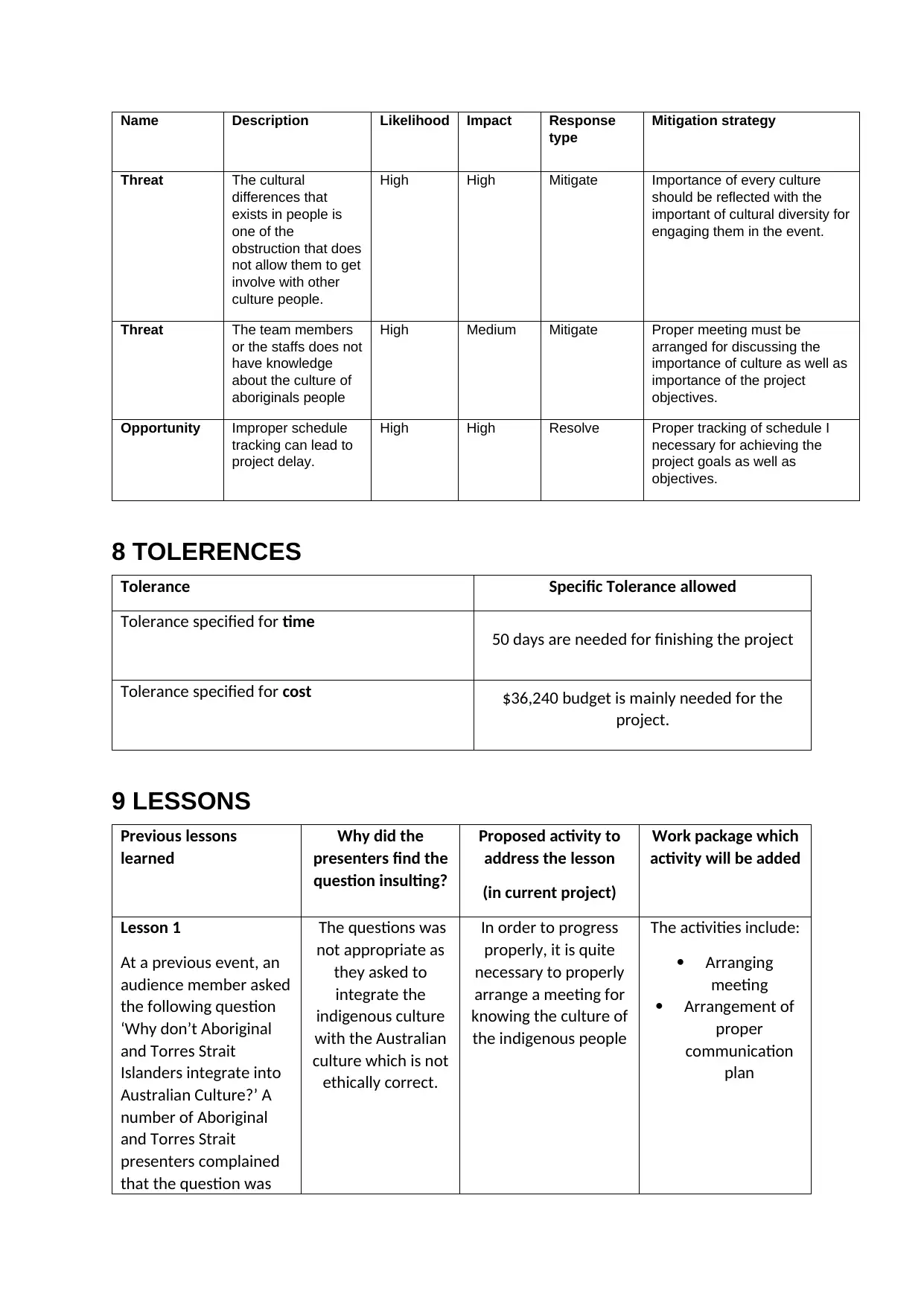
Name Description Likelihood Impact Response
type
Mitigation strategy
Threat The cultural
differences that
exists in people is
one of the
obstruction that does
not allow them to get
involve with other
culture people.
High High Mitigate Importance of every culture
should be reflected with the
important of cultural diversity for
engaging them in the event.
Threat The team members
or the staffs does not
have knowledge
about the culture of
aboriginals people
High Medium Mitigate Proper meeting must be
arranged for discussing the
importance of culture as well as
importance of the project
objectives.
Opportunity Improper schedule
tracking can lead to
project delay.
High High Resolve Proper tracking of schedule I
necessary for achieving the
project goals as well as
objectives.
8 TOLERENCES
Tolerance Specific Tolerance allowed
Tolerance specified for time
50 days are needed for finishing the project
Tolerance specified for cost $36,240 budget is mainly needed for the
project.
9 LESSONS
Previous lessons
learned
Why did the
presenters find the
question insulting?
Proposed activity to
address the lesson
(in current project)
Work package which
activity will be added
Lesson 1
At a previous event, an
audience member asked
the following question
‘Why don’t Aboriginal
and Torres Strait
Islanders integrate into
Australian Culture?’ A
number of Aboriginal
and Torres Strait
presenters complained
that the question was
The questions was
not appropriate as
they asked to
integrate the
indigenous culture
with the Australian
culture which is not
ethically correct.
In order to progress
properly, it is quite
necessary to properly
arrange a meeting for
knowing the culture of
the indigenous people
The activities include:
Arranging
meeting
Arrangement of
proper
communication
plan
type
Mitigation strategy
Threat The cultural
differences that
exists in people is
one of the
obstruction that does
not allow them to get
involve with other
culture people.
High High Mitigate Importance of every culture
should be reflected with the
important of cultural diversity for
engaging them in the event.
Threat The team members
or the staffs does not
have knowledge
about the culture of
aboriginals people
High Medium Mitigate Proper meeting must be
arranged for discussing the
importance of culture as well as
importance of the project
objectives.
Opportunity Improper schedule
tracking can lead to
project delay.
High High Resolve Proper tracking of schedule I
necessary for achieving the
project goals as well as
objectives.
8 TOLERENCES
Tolerance Specific Tolerance allowed
Tolerance specified for time
50 days are needed for finishing the project
Tolerance specified for cost $36,240 budget is mainly needed for the
project.
9 LESSONS
Previous lessons
learned
Why did the
presenters find the
question insulting?
Proposed activity to
address the lesson
(in current project)
Work package which
activity will be added
Lesson 1
At a previous event, an
audience member asked
the following question
‘Why don’t Aboriginal
and Torres Strait
Islanders integrate into
Australian Culture?’ A
number of Aboriginal
and Torres Strait
presenters complained
that the question was
The questions was
not appropriate as
they asked to
integrate the
indigenous culture
with the Australian
culture which is not
ethically correct.
In order to progress
properly, it is quite
necessary to properly
arrange a meeting for
knowing the culture of
the indigenous people
The activities include:
Arranging
meeting
Arrangement of
proper
communication
plan
Paraphrase This Document
Need a fresh take? Get an instant paraphrase of this document with our AI Paraphraser
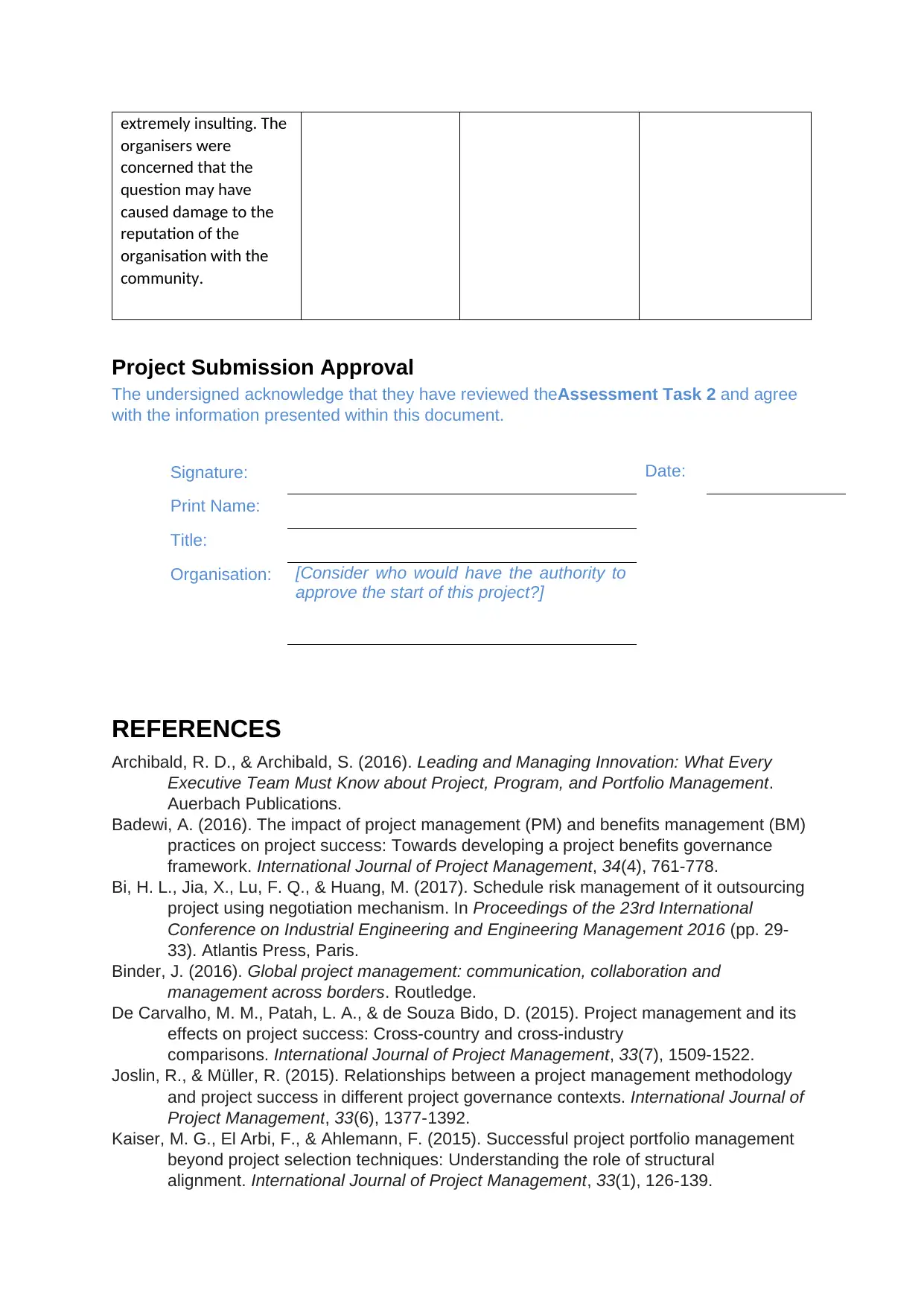
extremely insulting. The
organisers were
concerned that the
question may have
caused damage to the
reputation of the
organisation with the
community.
Project Submission Approval
The undersigned acknowledge that they have reviewed theAssessment Task 2 and agree
with the information presented within this document.
Signature: Date:
Print Name:
Title:
Organisation: [Consider who would have the authority to
approve the start of this project?]
REFERENCES
Archibald, R. D., & Archibald, S. (2016). Leading and Managing Innovation: What Every
Executive Team Must Know about Project, Program, and Portfolio Management.
Auerbach Publications.
Badewi, A. (2016). The impact of project management (PM) and benefits management (BM)
practices on project success: Towards developing a project benefits governance
framework. International Journal of Project Management, 34(4), 761-778.
Bi, H. L., Jia, X., Lu, F. Q., & Huang, M. (2017). Schedule risk management of it outsourcing
project using negotiation mechanism. In Proceedings of the 23rd International
Conference on Industrial Engineering and Engineering Management 2016 (pp. 29-
33). Atlantis Press, Paris.
Binder, J. (2016). Global project management: communication, collaboration and
management across borders. Routledge.
De Carvalho, M. M., Patah, L. A., & de Souza Bido, D. (2015). Project management and its
effects on project success: Cross-country and cross-industry
comparisons. International Journal of Project Management, 33(7), 1509-1522.
Joslin, R., & Müller, R. (2015). Relationships between a project management methodology
and project success in different project governance contexts. International Journal of
Project Management, 33(6), 1377-1392.
Kaiser, M. G., El Arbi, F., & Ahlemann, F. (2015). Successful project portfolio management
beyond project selection techniques: Understanding the role of structural
alignment. International Journal of Project Management, 33(1), 126-139.
organisers were
concerned that the
question may have
caused damage to the
reputation of the
organisation with the
community.
Project Submission Approval
The undersigned acknowledge that they have reviewed theAssessment Task 2 and agree
with the information presented within this document.
Signature: Date:
Print Name:
Title:
Organisation: [Consider who would have the authority to
approve the start of this project?]
REFERENCES
Archibald, R. D., & Archibald, S. (2016). Leading and Managing Innovation: What Every
Executive Team Must Know about Project, Program, and Portfolio Management.
Auerbach Publications.
Badewi, A. (2016). The impact of project management (PM) and benefits management (BM)
practices on project success: Towards developing a project benefits governance
framework. International Journal of Project Management, 34(4), 761-778.
Bi, H. L., Jia, X., Lu, F. Q., & Huang, M. (2017). Schedule risk management of it outsourcing
project using negotiation mechanism. In Proceedings of the 23rd International
Conference on Industrial Engineering and Engineering Management 2016 (pp. 29-
33). Atlantis Press, Paris.
Binder, J. (2016). Global project management: communication, collaboration and
management across borders. Routledge.
De Carvalho, M. M., Patah, L. A., & de Souza Bido, D. (2015). Project management and its
effects on project success: Cross-country and cross-industry
comparisons. International Journal of Project Management, 33(7), 1509-1522.
Joslin, R., & Müller, R. (2015). Relationships between a project management methodology
and project success in different project governance contexts. International Journal of
Project Management, 33(6), 1377-1392.
Kaiser, M. G., El Arbi, F., & Ahlemann, F. (2015). Successful project portfolio management
beyond project selection techniques: Understanding the role of structural
alignment. International Journal of Project Management, 33(1), 126-139.
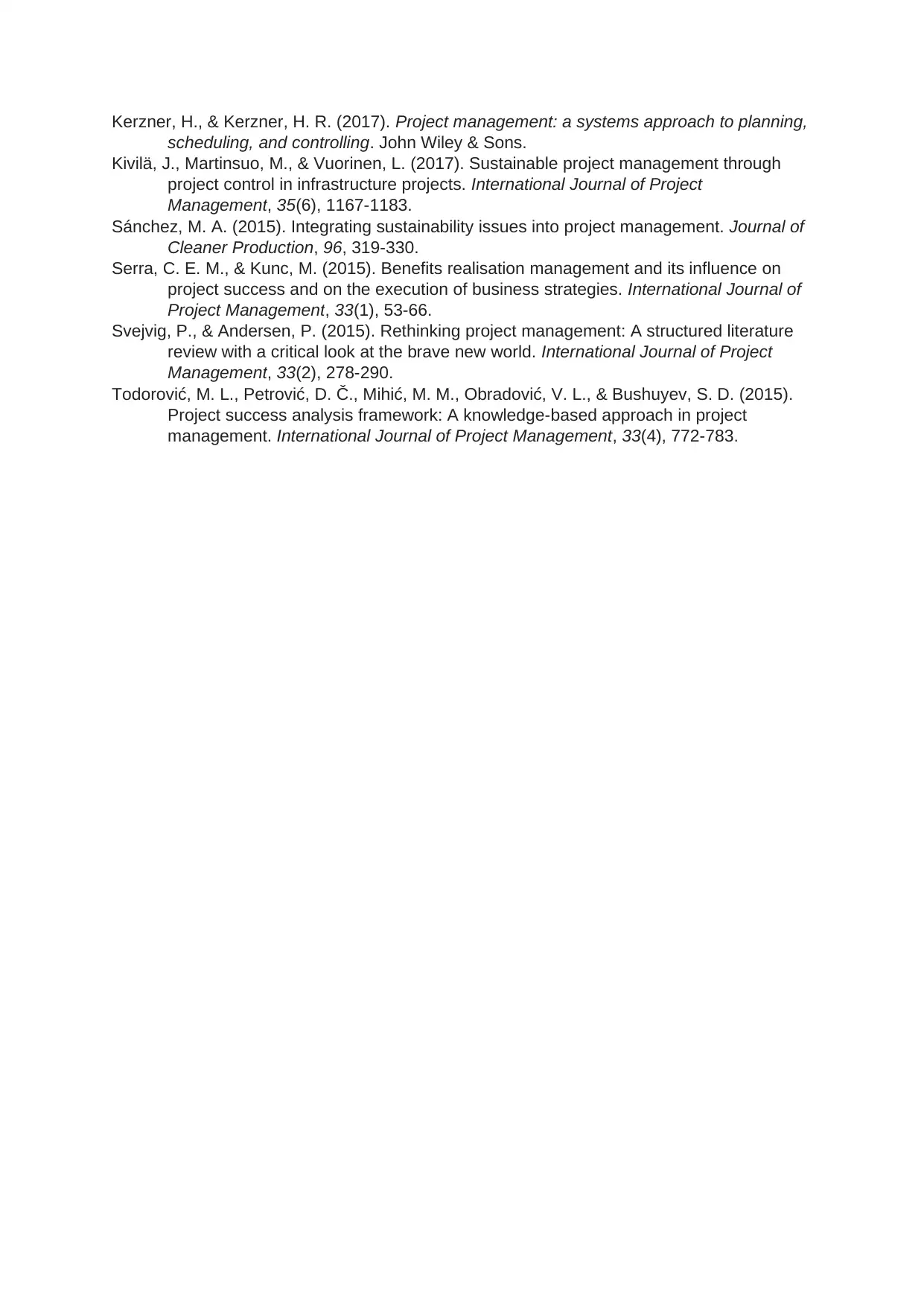
Kerzner, H., & Kerzner, H. R. (2017). Project management: a systems approach to planning,
scheduling, and controlling. John Wiley & Sons.
Kivilä, J., Martinsuo, M., & Vuorinen, L. (2017). Sustainable project management through
project control in infrastructure projects. International Journal of Project
Management, 35(6), 1167-1183.
Sánchez, M. A. (2015). Integrating sustainability issues into project management. Journal of
Cleaner Production, 96, 319-330.
Serra, C. E. M., & Kunc, M. (2015). Benefits realisation management and its influence on
project success and on the execution of business strategies. International Journal of
Project Management, 33(1), 53-66.
Svejvig, P., & Andersen, P. (2015). Rethinking project management: A structured literature
review with a critical look at the brave new world. International Journal of Project
Management, 33(2), 278-290.
Todorović, M. L., Petrović, D. Č., Mihić, M. M., Obradović, V. L., & Bushuyev, S. D. (2015).
Project success analysis framework: A knowledge-based approach in project
management. International Journal of Project Management, 33(4), 772-783.
scheduling, and controlling. John Wiley & Sons.
Kivilä, J., Martinsuo, M., & Vuorinen, L. (2017). Sustainable project management through
project control in infrastructure projects. International Journal of Project
Management, 35(6), 1167-1183.
Sánchez, M. A. (2015). Integrating sustainability issues into project management. Journal of
Cleaner Production, 96, 319-330.
Serra, C. E. M., & Kunc, M. (2015). Benefits realisation management and its influence on
project success and on the execution of business strategies. International Journal of
Project Management, 33(1), 53-66.
Svejvig, P., & Andersen, P. (2015). Rethinking project management: A structured literature
review with a critical look at the brave new world. International Journal of Project
Management, 33(2), 278-290.
Todorović, M. L., Petrović, D. Č., Mihić, M. M., Obradović, V. L., & Bushuyev, S. D. (2015).
Project success analysis framework: A knowledge-based approach in project
management. International Journal of Project Management, 33(4), 772-783.
1 out of 15
Related Documents
Your All-in-One AI-Powered Toolkit for Academic Success.
+13062052269
info@desklib.com
Available 24*7 on WhatsApp / Email
![[object Object]](/_next/static/media/star-bottom.7253800d.svg)
Unlock your academic potential
© 2024 | Zucol Services PVT LTD | All rights reserved.





